
| Brought to you by the US Department of Health and Human Services, Substance Abuse & Mental health Services Administration |
 |
Home  About Us About Us  Links Links  Get E-mail Updates Get E-mail Updates  Awards Awards |
 |
|||
|
|
|||||
| Send this page to a friend | Print this page |  |
||||
|
|
 |
 
Rhythm and RhymePoems are great pre-reading and early reading tools. Children can be engaged in the sounds of the words that build important reading skills:
They also build confidence because poetry and songs are easy to memorize, and matching the words on the page with the words they are saying helps children increase their reading vocabulary. Purpose:To help students learn pre-reading skills through poetry and songs using Building Blocks for a Healthy Future and the Sing-Along CD or online music. Materials:
Preparation:Use the Building Blocks for a Healthy Future Sing-Along CD or online music to find one or two songs for your students to sing and dance to. All of the songs have rhythm and rhyme that lead to easy reading and/or memorizing and dancing, as well as lyrics that are fun to act out. Download the music onto a CD, or use the computer and speakers to play the songs directly from the Web site. If you have a data projector, you can project the page of lyrics onto a screen. Otherwise, print out the lyrics and put them onto an overhead or write them onto large sheets of chart paper. Procedure:
Optional for Older StudentsHave older students put on a traveling show, going in small groups to classes of younger students to perform their songs. Or, have individual students use their song booklets to "read" and sing to younger students. Resources:
|
|||||
| Site Map | Contact Us | FAQ | Ask SAMHSA | Privacy Policy | Web Site Policies | FOIA | USA.gov | Plain Language |
|
Updated on 3/21/2012 |